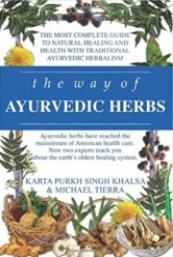Herbs for the Flu
By Karta Purkh Singh (K.P.) Khalsa
 Could anyone be more miserable? The running nose. The aching muscles. The pounding head. When the cold and flu season rolls around again, the bugs can give a good bite.
Could anyone be more miserable? The running nose. The aching muscles. The pounding head. When the cold and flu season rolls around again, the bugs can give a good bite.
Cold and flu (influenza) are caused by viruses. These bugs cannot be killed by chemicals — not by drugs like antibiotics, and not by herbal compounds. The only way to tame these diseases is to motivate the body’s own immune system. Herbs don’t just help eject the microbes. Infected people can also feel better while the immune system is doing its job by treating aches, congestion, cough and fever.
Herbal medicine regimes for infection include three fundamental steps. We must boot out the invader, nourish the tissue (in this case, the respiratory system) that allowed the infection to take root, and support the immune system to prevent relapse.
Just down with the flu? Herbalists know that if you hit it hard with potent natural medicines, you can be back in the pink in 24 hours. But you have to give it all you’ve got. Let’s start with a well-known North American herb, osha root. Found growing in the high altitudes in the Southwest and Rocky Mountain states and Mexico, osha root, or bear root (Ligusticum porteri) is a widely used remedy held in high esteem by Native American herbalists as a remedy for respiratory infections. This popular medicine goes by many names, including Mountain Ginseng, Mountain Carrot and even Empress of the Dark Forest. Some think it is the most widely used herbal medicine of indigenous people in this area. Osha is a member of the parsley family, which also includes carrot and dill. Today, herbalists of all schools often recommended osha root for use at the first sign of a respiratory infection.
Osha has a bitter taste, but the root has a numbing effect that soothes sore throats. It is also an expectorant, earning it the moniker Colorado Cough Root. Osha can be given together with echinacea for elevated white blood cells from infection.
A related plant, Szechuan lovage root (Ligusticum wallichii), is a useful remedy in Chinese medicine. Most scientific studies of the medicine were performed on the Chinese species. The plants are so similar that we can probably assume that the effects are consistent. It’s clear that the herb contains anti-inflammatory ingredients. Chinese research suggests that Ligusticum wallichii can relax smooth muscle tissue, benefiting cough, and inhibit bacteria growth. When combined with Astragalus, Ligusticum has demonstrated an outstanding immune enhancing effect.
Osha is available as whole or powdered dried roots. Try chewing whole dried osha root, although it has a strong, unusual taste. Moore suggests chewing a walnut-sized root every three to four hours. Powder in capsules doses out at 15 grams per day. Osha is believed to be safe. Traditionally, it is not recommended for use in pregnancy.
Already sick but want to recover faster? Andrographis might be your remedy. This herb (Andrographis paniculata) is a very widely used medicine in both Ayurveda and Chinese herbalism (TCM). It is a wild annual shrub from the plains of Asia that is also cultivated in the gardens of North India, where it’s been a household remedy in Asia for many centuries. In Ayurveda, which calls it kalmegh (king of the bitters), it is used for upper respiratory infection (flu, bronchitis). TCM utilizes Andrographis for fever and headache of colds and flu, tonsillitis, larynopharyngitis, bronchitis and inflammation. Andrographis has been used for more than a dozen years in Scandinavia for reducing the symptoms and duration of colds.
Still sick? Clearly, a longer-term strategy is called for. Chinese isatidis root (Isatis tinctora, Ban Lan Gen), an herb in the cabbage family, is a broad spectrum antimicrobial, with activity against many types of viruses and bacteria. It is used to reduce fever. You’ve heard of the popular Astragalus root. Where Astragalus is warming, isatidis is a cooling herb, so they combine well across a wide range of physiological conditions. According to TCM, Astragalus and isatidis both also fortify the lungs. Use a combination of these two herbs, or Isatidis as a single, at a total dose of about 20 grams per day, spread through the day. Both herbs are very safe.
Lomatium root (Lomatium dissectum) is also worth considering. Once widely considered to be a powerful healing agent by Native American healers, it was used extensively for influenza. In more recent times, Lomatium has had a bit if a Renaissance, used as an important remedy in the treatment of upper respiratory tract infections, both viral and bacterial in origin. Most people use Lomatium in tincture at a dose of 60-90 drops of the tincture, 3-4 times per day.
Getting the flu is a drag, but there’s usually a quick way out of the misery. Give these herbs a try. You can bounce back faster than you might think.
 Karta Purkh Singh (K.P.) Khalsa, Yogaraj (Ayurveda), AD, DN-C, RH, has 49 years of experience in holistic medicine, and is one of the foremost natural healing experts in North America.
Karta Purkh Singh (K.P.) Khalsa, Yogaraj (Ayurveda), AD, DN-C, RH, has 49 years of experience in holistic medicine, and is one of the foremost natural healing experts in North America.
He’s President Emeritus of the American Herbalists Guild, is nationally credentialed to teach herbalism, yoga, and Ayurvedic massage, and is one of the first nationally certified instructors of Kundalini yoga in the United States.
K.P., who holds a doctorate in Ayurveda, is a professor at Massachusetts College of Pharmacy, a founding faculty in the Ayurvedic Sciences program at Bastyr University, and a faculty member in the Botanical Medicine Department at the National College of Natural Medicine, where he trains naturopathic medical students and teaches Ayurveda.
He’s written or edited 30 books, including major works on Ayurveda, Chinese medicine, and physiology. His latest book, The Way of Ayurvedic Herbs, co-authored with Michael Tierra, brings Ayurveda to life in an understandable and practical way.
Catalyst is produced by The Shift Network to feature inspiring stories and provide information to help shift consciousness and take practical action. To receive Catalyst twice a month, sign up here.
This article appears in: 2020 Catalyst, Issue 19: Plant Medicine for Modern Epidemics Summit



